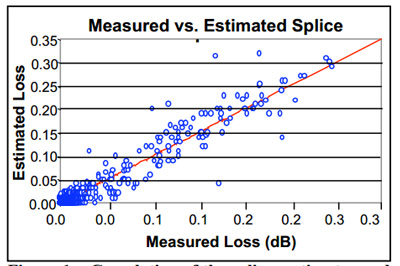Standards relating to splice loss measurement methods and test equipment are summarized in Appendix B. Again, we identified a number of important gaps: TIA 455-34A, the most widely recognized and comprehensive standard, does not mention the geometry error or nominal tolerances for test fibers, e.g. core concentricity, which is specified in Telcordia GR-765. Neither standard addresses other important fiber properties such as mode field diameter (MFD), core effective index and backscatter coefficient.
This information may not be necessary for the in-line methods, in which a single fiber is cut and spliced. However, in the cutback or bare fiber adapter (BFA) methods, in which the two fibers are likely to be dissimilar, intrinsic characteristics of the fibers, such as absorption, may need to be considered.
Measurement accuracy is specified in some standards. For example Telcordia GR-326 (single mode optical connectors and jumper assemblies) calls for accuracy within ±0.05 dB (section 5.2), and Telcordia TR-001196 (splice verification sets) requires ±0.2 dB and an objective of ±0.1 dB (section 4.1.1), for losses between 0.0 and 1.0 dB. [4, 6] However, the standards do not describe how to assess method accuracy. There is a need for traceable standard components (fiber splices or attenuators) in the low loss range of 0-0.05 dB, to avoid extrapolation and assumptions of linearity from the higher attenuation ranges covered by commercial instruments.
A source stability of measurement repeatability of 10% of the range requires stability of ±0.005 dB, or better. The best current data (in-line sets I-1 & I-2, see Results and Discussion section) demonstrate that short-term stability of ±0.001 dB is achievable.
However, the TIA 455-34A (section 3.1.3) target of ±0.02 dB is inadequate. At the same time, TIA provides for more precise low loss measurement by including a source monitor to control source drift. The TIA specification for detector resolution of 0.01 dB, for losses measurement.
Useful information on test set-ups, such as coupling the fiber to the detector (e.g. integrating sphere), use of fiber loops as high order mode filters, and isolators to prevent back reflections, is generally omitted. TIA 455-34A (sections 4.3 & 4.4) has the best coverage and mentions that for SMF the fiber coating is often sufficient to function as a cladding mode stripper, fiber lengths can be as short as 2 m, and there should be no bends with radii
Both the in-line and BFA methods are covered in TIA 455-34A, although TIA refers to “cutback method” or “pigtailed devices” when describing the loss tests described in this paper as BFA. Of the various standards reviewed, TIA 455-34A comes closest toward satisfying the need for a precision loss measurement method, and with some modification and addition, it could be adopted as a new standard for very low loss splicing.